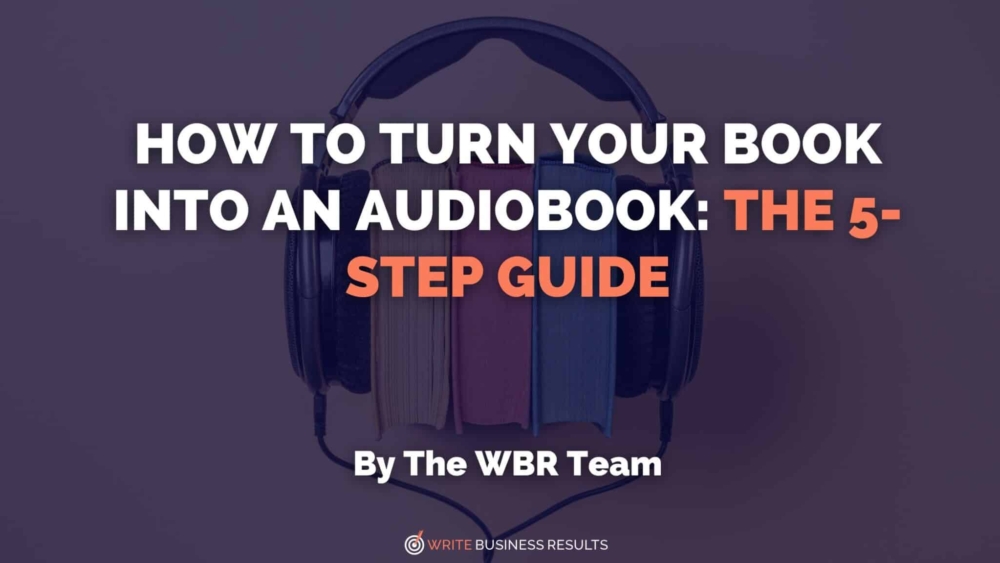By The WBR Team
What book format is the fastest-growing one in the publishing industry?
If you guessed audiobooks, you’re correct. According to Statista, sales revenue from consumer audiobook downloads in the UK alone reached £164 million in 2022, up by eight per cent from the previous year. Another 2023 study revealed that more than half (53 per cent) of US adults have listened to audiobooks at some point.
This means that there’s a huge opportunity for entrepreneurs who want to make the most of their business book to reach a broader audience and generate even more revenue. If you’ve been wondering how to make a book into an audiobook, we’ve broken down the process into five easy steps:
How to turn your book into an audiobook: the 5 steps to follow
2. Set up your recording equipment or liaise with a team.
3. Schedule your recording time.
4. Get an audio engineer to edit the files.
5. Tie up loose ends and choose a distribution channel.
1. Prepare your manuscript
Turning your book into a high-quality audiobook involves a lot more than just reading it aloud in a recording studio. There’s a lot of work that goes into making sure the manuscript is optimised and, if you skip this step, you’ll waste precious time and money.
Many authors who don’t realise this in time end up coming back to this first step or publishing a low-quality audiobook.
So, how do you prepare your manuscript for recording? There are a few considerations to make at this stage. First, you’ll need to decide how to handle any illustrations, charts, and graphs in your manuscript.
Some authors choose to provide PDFs that listeners can download for free when they purchase the audiobook. Another option might be to leave out/remove any illustrations (and explanatory text) that aren’t central to the message you’re passing across.
2. Set up your recording equipment or hire a team
At this stage, you want to decide if you’ll be hiring a professional audiobook production team or if you’ll be recording yourself. If this is your first audiobook, we recommend getting a team of professionals to handle it for you, especially if efficiency, quality, and speed are your priorities.
However, if you do choose to do it yourself, you’ll need to start by making sure you have a quiet space. Believe it or not, your environment is noisier than you think.
The hum of your laptop or your heating vent, birds chirping outside your window – these are all sounds that you probably don’t take note of, but best believe they will be picked up by your mic.
That’s why you need to set up a sound booth in the quietest part of your house to make sure you’re minimising noise as much as possible.
You’ll also need some audio gear, such as:
- A quality microphone
- A pop filter
- Headphones
- High-quality recording software.
All of these added up will cost a pretty penny, so you have to decide if it’s worth the investment or if you’re better off renting out a studio and equipment.
3. Schedule your recording time
Again, if you’re recording or reading your audiobook yourself, you’ll need to factor in recording time. On average, it takes about three hours to create one hour of content. This could take longer, especially if it’s your first time recording an audiobook.
Based on this, you want to make sure you have sufficient space in your schedule. Some authors might choose to hire a professional audiobook director to coach them through each recording session. However, you can still get great results reading it yourself with a little guidance and feedback at the start.
4. Get an audio engineer to edit the files
Once you’ve completed recording, it’s time to pass the audio files onto an audio engineer. They’ll clean up the audio and get the files ready for publishing. At this stage, you’ve already put in the hard work by making sure your audio is as good as it can be.
Now, you need to crown your efforts by hiring a professional – audio engineers who have previously worked on audiobooks and can effectively fill in any gaps in quality.
5. Tie up loose ends and choose a distribution channel
Once your audio files are ready for publishing, tie up any loose ends left, such as the audiobook cover design, creating a marketing plan, and so on. You also need to choose a distribution platform where you’ll host your new audiobook.
Some of the more popular choices are Amazon’s Audiobook Creation Exchange (ACX), Findaway Voices and Google Play Books. Make sure you properly research all of your options before making a final decision.
The bottom line
Turning your book into an audiobook can be a great choice for any entrepreneur. However, just like with a print book, you have to prioritise quality and efficiency from the get-go. Your audiobook won’t generate any additional revenue for you if it’s of shoddy quality.
If you’d like to learn more about the support we offer for audiobook production, book a Clarity Call today.
